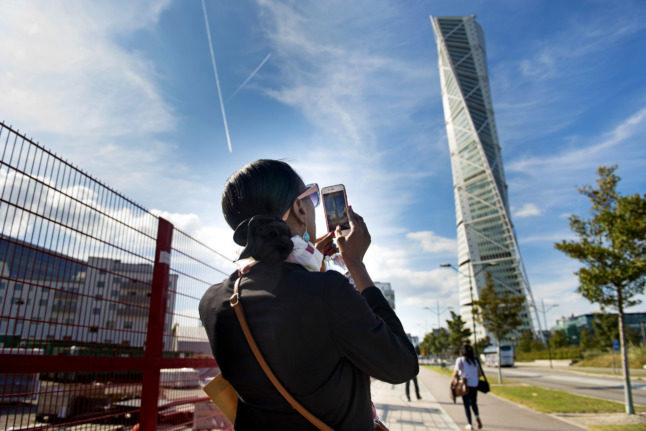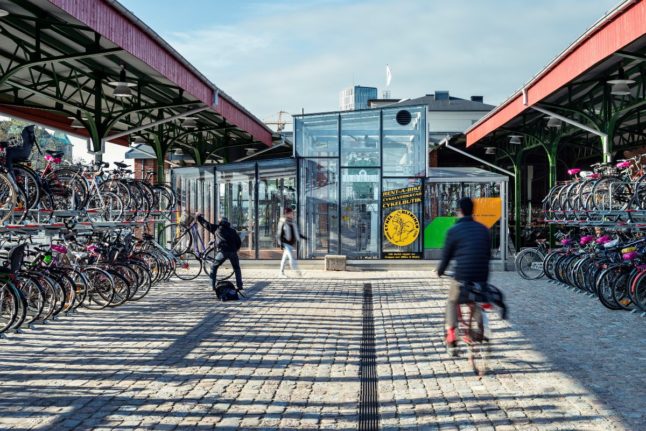There’s a lot of hype internationally about the “five-minute city”, cities designed so that all the important amenities are never more than five minutes’ cycle ride away.
Well, Malmö’s more or less there already. As the city’s slogan has it, i Malmö är det löjligt nära till det mesta (“in Malmö most things are ridiculously close”).
Whether you go for the area around St Knuts’ Square or Nobeltorget, or Slottstaden, or Gamla Väster, or Västra Hamnen, it’s gloriously convenient to be little more than a five-minute cycle from the Central Station and the main shopping district.
Here are some tips on how to making living in the city even more convenient.
Loan your transport pass
If you make a journey regularly, either from somewhere else in Skåne to Malmö, or from Malmö to Copenhagen, the monthly passes from the regional travel company Skånetrafiken are a godsend.
Best of all is the Sommarkort, or summer card, which for a bargain price gives you unlimited travel across Skåne from June 15th until August 15th.
But something many don’t know about the Skånetrafiken passes is that you can lend them out or borrow them once a day for four hours or more, simply by sticking someone else’s phone number in your Skånetrafiken app.
This has led to lots of groups springing up on Facebook where you can borrow a card, or rent one out, for a lot cheaper than it would cost to buy a train ticket for the same period, such as here, or here, or here. This group, where people buy and sell commuter tickets across the bridge to Copenhagen is also very active.
Barnloppis
If you have small children, the children’s fleamarket or barnloppis in Bulltofta (formerly Folketspark) is an amazing way to stock up on clothes, toys, and picture books (not to mention prams, potties and the like). Most items go for as little as five kronor a piece, saving you a fortune.
Once your children have outgrown them, you can set up your own stall and sell them all back.

Annual museum passes
For parents or for expats expecting lots of visitors, the årskort, or annual pass, for Malmö’s museums is, at 150 kronor, excellent value for money and will mean you always have something to do on rainy afternoons and weekends. Both Malmö museum, with its aquarium and old-fashioned collection of stuffed animals, and the city’s technical museum are a winner with children (who go free).
Explore the diverse food options
Malmö is probably the Swedish city with the most integration between locals and immigrants, with the area around Möllevången square, in particular, offering something for everyone. Take advantage of this.
It means you can get a delicious falafel roll for as little as 25 kronor, which is probably cheaper than you can prepare a meal for yourself at home.
It also means you can eat lots of other incredible and very good value food — say, the tasty sesame breads at Nansis bageri just off the square, or delicious Syrian shakriyyeh or foul at Shamiat.
The vegetable market at Möllevången is also a cheaper place to buy fruit and veg than Coop or ICA, particularly if you do your shopping about an hour before it closes on Saturday afternoons.
It’s also worth checking out the supermarkets run by and aimed at first and second-generation immigrants, like Özen Allfrukt, Orient Food, or Lucu Food.
They are usually cheaper than Sweden’s big supermarkets, and have most of the basics, arguably better fruit and veg sections, and, if you’re curious, lots of interesting foods to try from all over the world.
It’s not a supermarket, but IndoPak, the South Asian food store in Dalaplan, is a great place to pick up rice, pulses and spices in bulk, as well as African and Caribbean staples.
Avoid summer crowds by using the last pier at Ribban beach
Ribersborg, or Ribban, Malmö’s beach, is one of the best things about the city in the summer. But it can get crowded.
If you go out to the last pier, in front of the Öresunds Funkis handicapped swimming area, it’s considerably quieter than the piers closer to the city centre.
Join local Facebook groups
Joining local Facebook groups is a great way of getting to know other foreigners in the city, but also for finding fellow enthusiasts for every sort of interest imaginable.
The Malmö Expats group, where foreigners share tips, is very active, as is the more anglocentric English-speaking, Malmö-dwelling Society.
For people who commute back and forth to Copenhagen, there’s the BroenLive group or the Öresundspendlare group.
Get on all school and kindergarten waiting lists
Whether you agree with Sweden’s system of parental choice for schools or not, it is a reality, and, for now, it operates on a queue system, so it pays to apply to all your local kindergarten cooperatives and all the local free schools pretty much as soon as your child is born.
Even if you want to send your child to a municipal school or kindergarten, you can never guarantee you will get a place at a good one, and if you’re in a lot of queues for private or cooperative alternatives, you have more options.
Use Malmö’s excellent libraries, particularly the book delivery service
Malmö’s libraries are fantastic, providing places to study, write novels, to read paper newspapers from around the world, for parents to take their small children, and for slightly older children to hang out.
While the main city library is wonderful, the smaller, satellite libraries are even better, or at least more innovative.
There’s Garaget, which is more of a lovely airy hangout or social space than a traditional library, with a place where children can do art projects, a play area, tool hire, a good cafe, and lots of events. There’s Stadsarkivet, which as well as a place for those researching local and family history, is a central quiet place to study.
And anyone who thinks that Rosengård isn’t worth a trip should visit the library there and see how much studying and general self-improvement is going on.
One of the best things about Malmö’s libraries is that you can log into the catalogue and order any book you like to be delivered to the one closest to you.

Take up skateboarding
Malmö has invested so heavily in skateboarding infrastructure that it really pays off if you start skating, or at least encourage your kids to. There’s the fantastic Bryggeriet indoor skate centre (with its Old Bastards session on Saturdays for you ageing skaters).
There’s the Stappelbädsparken skatepark in Västra Hamnen. There are skate ramps in Folketspark and Rörelseparken, and more, and benches and other street furniture in Värnhemstorget and Nobeltorget that has been specially designed with skaters in mind.
The city even employs an official skate coordinator, who runs the SkateMalmö website and organises the busy schedule of local and international competitions.
Get a Malmö by Bike pass
At 250 kronor for a year’s pass, Malmö by Bike is also a total no-brainer. Even if you own a bicycle (and if you don’t, why not?), it’s so useful if you’ve left it at home to be able to just grab a bike almost anywhere in the city centre and then drop it off wherever you’re going to.
Know where the city’s electrical bicycle pumps are
Malmö is a cycle city and the municipality has installed more than 30 bicycle pumps at strategic places around the city, most of them electric. You can see where they are on the map here, and then plan your trips so that your tyres are always pumped to perfection.
There are also two free cycle service stations, one on Pildammsvägen near the old Malmö IP stadium, and one in Västra Hamnen where Stora Varvsgatan meets Hallenborgs gata, which have basic tools and water jets to clean your ride.
Sign up for all the rental waiting lists as soon as you can
Whether you are single and only planning on staying in Malmö for a few years, happily married and the proud owner of a new property, or renting second hand, it’s almost always worth signing up to Boplatssyd, Malmö’s main rental waiting list, even if it’s just as a sort of insurance.
For just 300 kronor a year, you are on the waiting list, so if you unexpectedly fall in love and want to stay in Malmö, or, less happily, separate from your partner, and need your own apartment, you’ll be glad if you find that you’re suddenly eligible for a property.
Head to other parts of town to get good deals
It can really pay in Malmö to head out of the city centre to make the most of the smaller businesses based there, often run by first- or second-generation immigrants.
It’s often much cheaper and easier to get your car fixed by a mechanic in Rosengård or the area around Norra Grängesbergsgatan than it is to take it to a chain like Mekonomen.
Getting your car washed on Norra Grängesbergsgatan can cost as little as 99 kronor. The same goes for a lot of other services, like getting your bicycle fixed, clothes mended, or hiring a van and some help when moving house.
Norra Grängesbergsgatan has in the past been raided by the police, and the local Sydsvenskan newspaper has run a long-running investigative campaign against Den Svarta Malmö, or “the black (under the table) Malmö”, looking at how some companies don’t pay tax, give employees proper pay or contracts, or otherwise abide by the law.
But when the street was raided in March this year, police spokesman Nils Norling was at pains to point out that most businesses on the street are not breaking the law.
“Norra Grängesbergsgatan is full of businesses and most of them are legit,” he said. “But there’s a little clique that are not interested in laws or rules.”



 Please whitelist us to continue reading.
Please whitelist us to continue reading.
Just be aware the “last” pier at Ribban is usually full of nudists, if that’s not your thing!
Good tips ale always highly welcome, but trying to save on relatively cheap public transport is really sad in my opinion. If we want to use good quality transport services we should avoid tricks like „paying someone to lend his ticket”. Sorry to say.